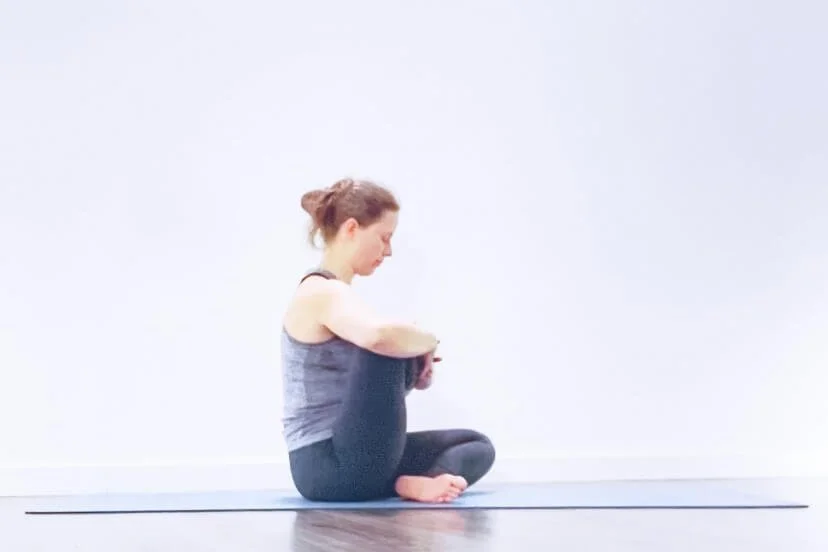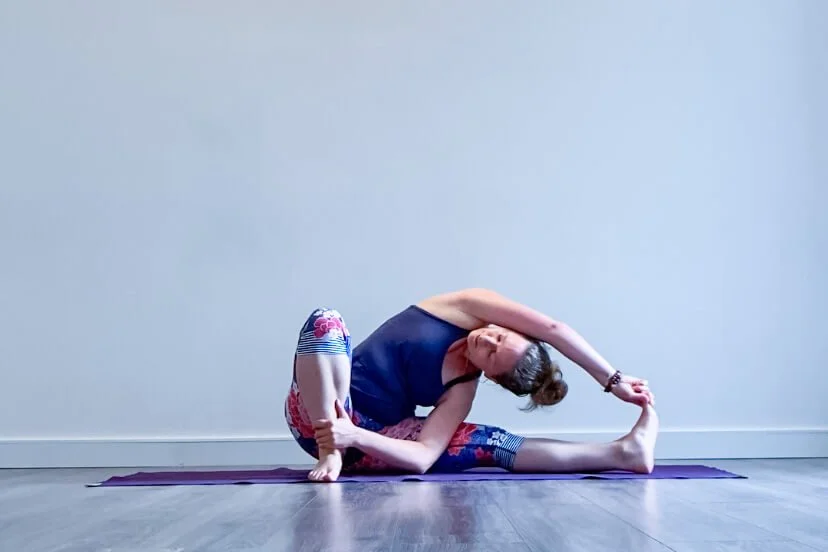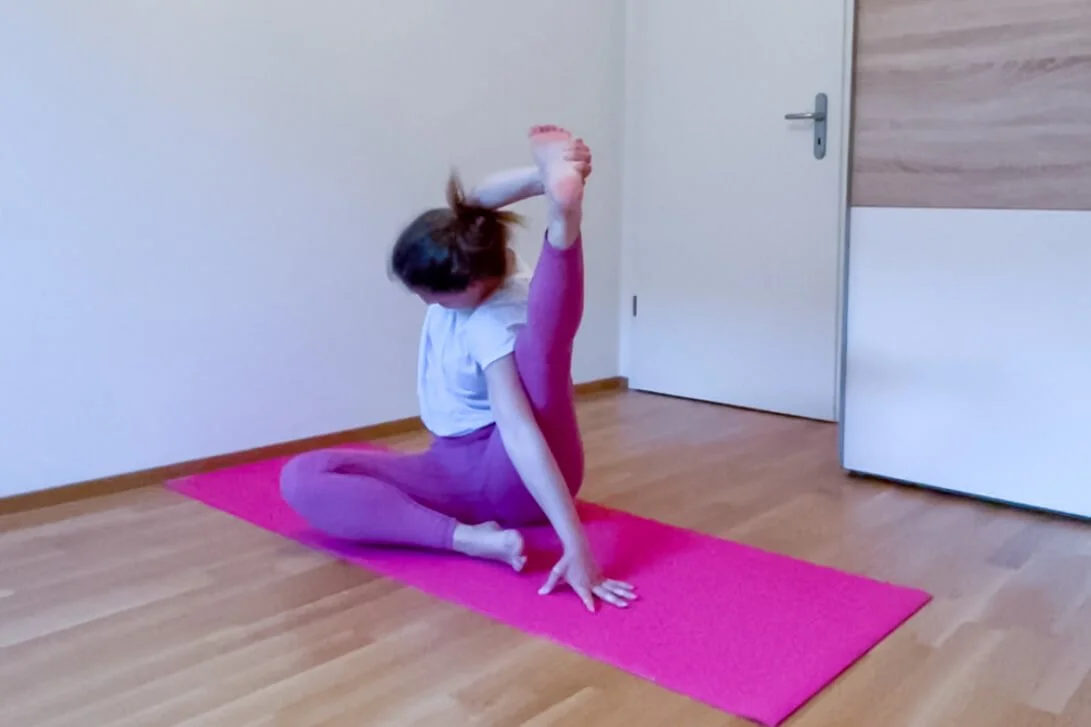ASANA: Your Complete Guide to Compass Pose - Benefits, Tips, and Modifications
Contemporary yoga boasts around 200 poses, as listed by B.K.S Iyengar in his book "Light on Yoga" in 1966. Yoga keeps evolving, especially since variations of existing poses are practised. So, it's not surprising to see new poses that haven't made it into a book yet.
After some research, it appears that Compass pose (Parivrtta Surya Yantrasana in Sanskrit) is one of the newcomers.
In this article, you will discover the benefits and the lovely meaning of this pose, as well as useful tips and modifications to help you practice it safely.
So, what exactly is Compass Pose, and what is its symbolism?
The Compass pose is a seated, twisted pose. You can think of it as a variation of the Cradle Pose (Hindolasana), where you bend one leg in front of your chest, placing the foot in the opposite elbow and the knee in the same elbow of the same arm to open your hip. It can also be seen as a variation of Parivrtta Janu Sirsasana, where one leg is extended to the side, and the other is bent as you lean over the extended leg.
Cradle pose - Hindolasana
Twisted head to knee pose - Parivrtta Janu Sirsasana
Looking at the picture below, you'll understand why it's called the Compass Pose. The Sanskrit name "Parivrtta Surya Yantrasana" translates similarly. "Parivrtta" means twist, "Surya" (as in Surya Namaskar - Sun Salutation) means "sun," "Yantra" means "instrument," and "Asana" translates to "pose."
Compass pose - Parivrtta Surya Yantrasana
So, this pose is your guide to reconnecting with yourself, your goals, your values, and your expectations. In this way, it completely aligns with B.K.S. Iyengar's idea of viewing the body as an instrument for our minds.
3 Interesting Benefits of the Compass Pose
Patience and Acceptance
To practice Compass Pose, it's essential to take your time & to warm up.
You can improve shoulder mobility by relaxing the trapezius muscles and doing mobility exercises. It's also important to warm up your adductors and hamstrings with postures such as Triangle Pose, Warrior 2, or Pyramid Pose.
At some point, your preparation may not allow you to perform the Compass Pose exactly as you see in the pictures. Yoga is a highly personal practice, and the shape of a pose won't look identical for everyone.
That's what's great about yoga, in my opinion: accepting that we can all practice a certain pose, but it will reflect who we are. Accepting this concept alleviates frustration and makes your practice even more enjoyable!
Stretching muscles of the inner thighs and torso, Mobility of the shoulders
In this pose, one of your legs is extended upward to the side. This action stretches key muscles inside your thigh, such as hamstrings and adductors. You might not notice it much, as your focus will be on the inside of your leg, but the Compass Pose also stretches the muscles on the outside of your hip, especially the gluteus maximus.
Additionally, the position of your arm above your head and the lateral flexion required to reach your foot stretches all the lateral muscles of your torso: your latissimus dorsi, obliques, and quadratus lumborum. This stretch helps relieve tension in your back and improves your breathing!
Balance Enhancement
It may sound strange since the Compass Pose is a seated posture, but when you practice it, you'll realize it requires some effort to maintain balance.
In turn, this will strengthen your core muscles as you work to maintain stability. It will also increase your proprioception as you adjust your body's position in space to stay balanced.
Therefore, it helps improve your balance in other poses, especially the standing ones.
How to Warm Up for the Compass Pose with Ease and Safety
Warming up is crucial for performing the Compass Pose comfortably, as it stretches tight or contracted muscle groups.
So, any poses that allow you to stretch your hamstrings and adductors while opening your hips will be helpful. These may include Triangle Pose, Warrior 2, Butterfly Pose, seated forward bends with legs in a V shape, or the previously mentioned Parivrtta Janu Sirsasana (which also warms up the lateral muscles of your torso). You can also warm up these muscles by using a yoga block or a book, placing your foot on it and gently bending and straightening your leg (see the video above).
To safely prepare for the Compass pose, also include lateral flexion poses and mobility exercises to warm up your shoulders. For example, try the Cow’s Face Pose by raising one arm above your head and the other behind your back, then trying to touch your hands in the middle of your back. You can also do circular arm movements in a V shape while holding a belt or strap with your hands. These exercises will reduce the risk of potential injuries and help you to prepare your shoulders for the pose.
Step-by-Step Guide to Getting into the Compass Pose
There are several ways to enter the Compass Pose since it's a variation of either Parivrtta Janu Sirsasana or the Cradle Pose.
a. Entering the Pose from Parivrtta Janu Sirsasana:
Step 1 - sit in Parivrtta Janu Sirsasana:
Begin by sitting with one leg bent outward, the heel close to your pelvis
Place the other leg extended to the side.
Lengthen your spine and raise the arm on the side of the bent leg above your head
While keeping your spine as long as possible, bend over your extended leg
Turn your chest toward the ceiling
In Parivrtta Janu Sirsasana, gently stretch the muscles along your chest and inner thigh, avoiding forceful stretching that can strain the adductors.
Tip: if you're far from your foot and have to bend your knee because it's too tight on the inside of your leg, it's a good sign to consider for the Compass Pose. You'll likely need a strap or belt to wrap around your foot.
Step 2 - transition to Compass pose:
From this position,
Reach for your foot with the hand that's above your head
Tip: you can bend your leg or turn your chest toward the ground if needed.
With your other hand, push the ground to help lift your leg off the floor. Do this slowly to gauge how your shoulder or the inside of your leg responds. Once again, depending on your flexibility, use a strap or belt for support
Turn your torso in the opposite direction of the leg you just lifted, passing the shoulder of the hand on the ground in front of your leg. You can look in that same direction or wherever feels most comfortable
Voilà, you're in the Compass Pose!
b. Entering the Pose from the Cradle Pose (Hindolasana):
Step 1 - sit in Cradle Pose:
Begin in the Cradle Pose.
Sit on the floor with one leg bent, knee open to the side, and the heel near your pelvis
Bend the other leg and bring the knee toward your chest
Place this knee in the elbow of the same arm and the foot in the elbow of the opposite arm
Tip: if you can't place your knee and foot in your elbows, no problem. You can hold them in your hands
You're now in the Cradle Pose.
Step 2 - transition to Compass Pose:
Try to pass the leg you're holding behind your arm. Once again, this will depend on the mobility of your hip. If it's not possible, use a strap or belt
If your leg is behind your arm, reach for the outside of your foot with the hand on the opposite side. Then, pass the arm of that hand behind your head
Tip: if it feels tight in your shoulder and you think your arm is too short, try sliding your shoulder blade upward to create more space for your head. If that's not enough, use a strap or belt to extend your arm.
Slowly start to extend your leg to the side while paying attention to any sensations in your leg or shoulder to ensure you're not pushing too far.
And there you have it! You're in the Compass Pose.
Useful Additional Tips
When passing your arm behind your head, if you feel tension in your shoulder, lift your shoulder blade to create more space. Remember to relax your trapezius muscles, located between your shoulder and neck, as they tend to contract when you bring your shoulder closer to your neck. To prevent this contraction, push your foot into your hand to help your arm move. In yoga postures, it's common to use the strength of one part of your body to relax other muscles.
Also, it's completely fine if the hip of the leg you're extending starts to lift.
Finally, if you feel like you're rolling backwards, check if you're sitting toward the back of your pelvis. If so, shift your weight toward the front of your pelvis.
Nice Ways to Modify the Compass Pose and Use Props
Strap or Belt:
As you've seen in the step-by-step guide, a strap can be very helpful to lengthen the arm holding your leg or assist in extending your leg by pressing your foot into the strap, especially if your shoulders or leg muscles are tight. In any case, you'll place the foot of the leg you want to extend in the strap and hold the strap with the opposite hand.
Wall:
Maintaining balance in the Compass Pose, despite being a seated pose, requires some effort. Placing the foot of your extended leg against a wall can be very helpful. The wall can also help you extend your leg by pressing against it, much like using a strap.
Things to Focus on When Practicing the Compass Pose
The Compass Pose requires a certain level of mobility in your hips, inner thighs, shoulders, and lateral muscles.
When practising it, take it slowly and pay attention to the sensations. If it's uncomfortable, there's no need to push further. Breathe and consider using a strap or the wall to assist. Otherwise, move on to another pose.
2 Cool Variations of the Compass Pose to Try
If you don’t feel like practising the Compass pose, you can feel the stretch of your hamstrings and adductors, sitting with your legs in a V shape and bending forward.
If you want to challenge your balance (do this near a wall or with someone who can catch you if needed), you can try the standing Compass Pose.



